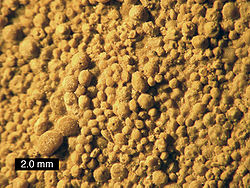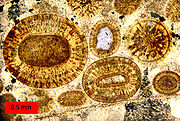
Ooid
Encyclopedia


Calcium carbonate
Calcium carbonate is a chemical compound with the formula CaCO3. It is a common substance found in rocks in all parts of the world, and is the main component of shells of marine organisms, snails, coal balls, pearls, and eggshells. Calcium carbonate is the active ingredient in agricultural lime,...
, but sometimes made up of iron
Iron
Iron is a chemical element with the symbol Fe and atomic number 26. It is a metal in the first transition series. It is the most common element forming the planet Earth as a whole, forming much of Earth's outer and inner core. It is the fourth most common element in the Earth's crust...
- or phosphate-based minerals. Ooids usually form on the sea floor, most commonly in shallow tropical seas (around the Bahamas, for example, or in the Persian Gulf
Persian Gulf
The Persian Gulf, in Southwest Asia, is an extension of the Indian Ocean located between Iran and the Arabian Peninsula.The Persian Gulf was the focus of the 1980–1988 Iran-Iraq War, in which each side attacked the other's oil tankers...
). After being buried under additional sediment
Sediment
Sediment is naturally occurring material that is broken down by processes of weathering and erosion, and is subsequently transported by the action of fluids such as wind, water, or ice, and/or by the force of gravity acting on the particle itself....
, these ooid grains can be cemented together to form a sedimentary rock
Sedimentary rock
Sedimentary rock are types of rock that are formed by the deposition of material at the Earth's surface and within bodies of water. Sedimentation is the collective name for processes that cause mineral and/or organic particles to settle and accumulate or minerals to precipitate from a solution....
called an oolite
Oolite
Oolite is a sedimentary rock formed from ooids, spherical grains composed of concentric layers. The name derives from the Hellenic word òoion for egg. Strictly, oolites consist of ooids of diameter 0.25–2 mm; rocks composed of ooids larger than 2 mm are called pisolites...
. Oolites usually consist of calcium carbonate meaning they belong to the limestone
Limestone
Limestone is a sedimentary rock composed largely of the minerals calcite and aragonite, which are different crystal forms of calcium carbonate . Many limestones are composed from skeletal fragments of marine organisms such as coral or foraminifera....
rock family. Pisoids
Pisolite
A pisolite is a sedimentary rock made of pisoids, which are concretionary grains - often of calcium carbonate, but sometimes of rarer minerals - which resemble ooids but are always more than 2 mm in diameter. These grains are approximately spherical and have concentric layers reaching...
are similar to ooids, but are larger than 2 mm in diameter, often considerably larger, as with the pisoids in the hot springs at Carlsbad (Karlovy Vary) in the Czech Republic.
Formation
An ooid forms as a series of concentric layers around a nucleus. The layers contain crystals arranged radially, tangentially or randomly. The nucleus can be a shell fragment, quartz grain or any other small fragment. Most modern ooids are aragoniteAragonite
Aragonite is a carbonate mineral, one of the two common, naturally occurring, crystal forms of calcium carbonate, CaCO3...
(a polymorph of calcium carbonate); some are composed of high-magnesium calcite
Calcite
Calcite is a carbonate mineral and the most stable polymorph of calcium carbonate . The other polymorphs are the minerals aragonite and vaterite. Aragonite will change to calcite at 380-470°C, and vaterite is even less stable.-Properties:...
, and some are bimineralic (layers of calcite and aragonite). Ancient ooids can be calcitic, either originally precipitated as calcite (as in calcite seas), or formed by alteration (neomorphic replacement) of aragonitic ooids (or the aragonite layers in originally bimineralic ooids). Moldic ooids (or molds later filled in by calcite cement) occur in both young and ancient rocks, indicating the removal of a soluble polymorph (usually aragonite).
Variation
Whether ooids become calcitic or aragonitic can be linked to strontium/calcium substitution within the crystalline structure. This has been shown in some examples to be due to temperature fluctuations in marine environments, which affects salinity levels, which in turn facilitate the substitution. Marine calcitic ooids were typically formed during calcite seaCalcite sea
A calcite sea is one in which low-magnesium calcite is the primary inorganic marine calcium carbonate precipitate. An aragonite sea is the alternate seawater chemistry in which aragonite and high-magnesium calcite are the primary inorganic carbonate precipitates...
intervals, especially during the Ordovician
Ordovician
The Ordovician is a geologic period and system, the second of six of the Paleozoic Era, and covers the time between 488.3±1.7 to 443.7±1.5 million years ago . It follows the Cambrian Period and is followed by the Silurian Period...
and the Jurassic
Jurassic
The Jurassic is a geologic period and system that extends from about Mya to Mya, that is, from the end of the Triassic to the beginning of the Cretaceous. The Jurassic constitutes the middle period of the Mesozoic era, also known as the age of reptiles. The start of the period is marked by...
Periods. The geochemistry of these seas was a function of seafloor spreading
Seafloor spreading
Seafloor spreading is a process that occurs at mid-ocean ridges, where new oceanic crust is formed through volcanic activity and then gradually moves away from the ridge. Seafloor spreading helps explain continental drift in the theory of plate tectonics....
and fluctuating Mg/Ca ratios. Low Mg/Ca ratios favor the precipitation of low-magnesium calcite.
Growth mode
Ooids with radial crystals (such as the aragonitic ooids in the Great Salt LakeGreat Salt Lake
The Great Salt Lake, located in the northern part of the U.S. state of Utah, is the largest salt water lake in the western hemisphere, the fourth-largest terminal lake in the world. In an average year the lake covers an area of around , but the lake's size fluctuates substantially due to its...
, Utah, USA) grow by ions extending the lattices of the radial crystals. The mode of growth of ooids with tangential (usually minute needle-like) crystals is less clear. They may be accumulated in a "snowball" fashion from tiny crystals in the sediment or water, or they may crystallize in place on the ooid surface. A hypothesis of growth by accretion (like a snowball) from the polymineralic sediment of fine aragonite, high-magnesium calcite (HMC) and low-magnesium calcite (LMC), must explain how only aragonite needles are added to the ooid cortex. Both in tangential and in radial ooids, the cortex is composed of many very fine increments of growth. Some modern (and ancient) ooids partially or totally lack clear layering and have a micritic (very fine grained) texture. Examination of such micritic ooids by scanning electron microscopy often shows evidence of microbial borings later filled by fine cement.
Growth factors
There are several factors that affect ooid growth: supersaturation of the water with respect to calcium carbonate, the availability of nuclei, agitation of the ooids, water depth, and the role of microbes.Structural similarity
Kidney stoneKidney stone
A kidney stone, also known as a renal calculus is a solid concretion or crystal aggregation formed in the kidneys from dietary minerals in the urine...
s are similar to ooids in their layered structure; they are sometimes rich in calcium (calcium oxalate) or phosphate (struvite).

